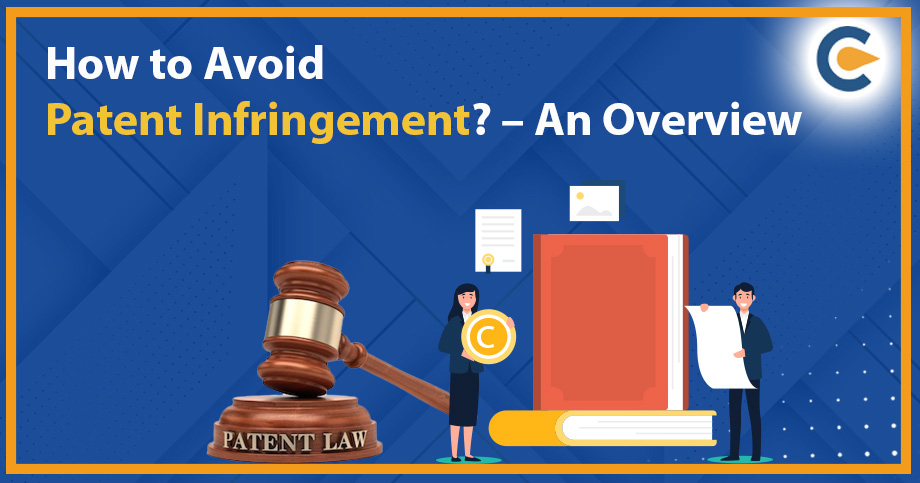A patent is a legal document granted by the Government, which confers an exclusive statutory right in favour of the inventor in exchange for disclosure of the invention to the public for general usage. A Patent provides for a monopoly over an invention. According to the Patent Act, 1970, the invention should be such that it is new and useful and presents a new manner of doing something or must be non-obvious in a way that it is an improvement to existing technology. Patent rights are granted for inventive products and processes which meet the criteria of novelty, non-obviousness, and usefulness. Scroll down to check different ways to avoid Patent Infringement.
What is Patent Infringement?
Before we discuss different ways to avoid Patent Infringement, let’s understand the meaning of Patent Infringement. Patent infringement is nowhere defined in the Patent Act, 1970[1]. However, Section 48 provides exclusive rights to the patent-holder to prevent any person not being authorized under the patent or having a license thereto from “making, using, offering for sale, selling or importing” the invention for the same purpose in India. Any infringement of this exclusive right would be considered patent infringement.
Patent infringement can be direct as well as indirect. Direct infringement involves the commercial usage or sale of an identical or similar patented item or process without the consent of the patentee. Indirect infringement involves acts by third parties which causes another to infringe a patent or involve importing or procuring parts which are to be specifically used in a patented product.
Patent infringement can lead to imprisonment or civil liabilities like injunctions, damages and costs, and seizure of infringing material for any loss caused to the patent-holder.
Ways to Avoid Patent Infringement
It is always prudent to be mindful of existing patents in the market to avoid the risk of incurring liability for patent infringement. Due diligence in this regard can help avoid the risk of the product becoming redundant, wasting time, intellectual resources, and investment, and paying hefty sums in damages. Hence, the process of searching, determining, and evaluating patents is an important step. Following are some different ways to avoid Patent Infringement.
- Create and Check
This process focuses more on the development of new ideas resulting in novel products, technology, and manner of usage or providing new advantages to users and then conducting a search of the existing patents. This is followed majorly in industries which do not have many new products or process inventions and where patent prosecutions and infringements are relatively fewer. Once the idea is moulded in a manner that it can be a potentially patentable product or process, then a patent search is carried out to check the existence of patents based on similar ideas. If the search results in the existence of similar patents and the new product/process infringe the existing one, the latter is modified accordingly. This is a relatively low-cost way to avoid patent infringement as it happens in the early stages of development and hence can be used to avoid liabilities or actions without major delays.
- Identify and Avoid
This is one of the important ways to avoid Patent Infringement. This technique is used in situations where a new product has already been developed using new technology or process and the same has received a lot of traction in the market. The inventor plans to create a product using the same technology but in a manner that the new feature would be protected by a patent. The inventor then identifies the existing patents which protect the interesting product, and the claims are assessed in depth to understand the ambit of what is covered under the patent. This is followed by process of elimination, where an alternative product producing the same effect can be created in a manner that does not cause infringement. Then a search is conducted again to ensure that the new product does not infringe on any existing patent.
- Search, Create and Check
This is also one of the important ways to avoid Patent Infringement. This technique is used in spheres where there is no dearth of existing technologies and rival patents, which can potentially cause the rejection of a patent for the new product or process in mind. An extensive patent search covering a few major areas in which the function of the existing patent is conducted, and a comprehensive understanding of the rival patents and their ambit of function is arrived at. Simultaneously, several ideas for a possible product or process are created and they are compared against the patents identified in the patent search. The ideas and the identified patents are used as parameters to zero in on the final idea to be selected. The new design created can be cross-checked against the identified patents and the existing patents as a whole to rule out possibilities of infringement.
Conclusion
Patents provide exclusive rights to inventors to monopolize and profit from their inventions in exchange for making the products, process, or technical know-how available to the general public for usage in a manner that doesn’t infringe the rights under the patent. Inventors need to be mindful of the existing patents in the market to avoid infringement of another’s patent. Conducting due diligence at the initial stages can be beneficial and not only help in avoiding risks of potential patent lawsuits, imprisonment and hefty penalties but can also help avoid the wastage of one’s own time, money and resources.
Read Our Article:Patent Infringement Letter: All You Need To Know











